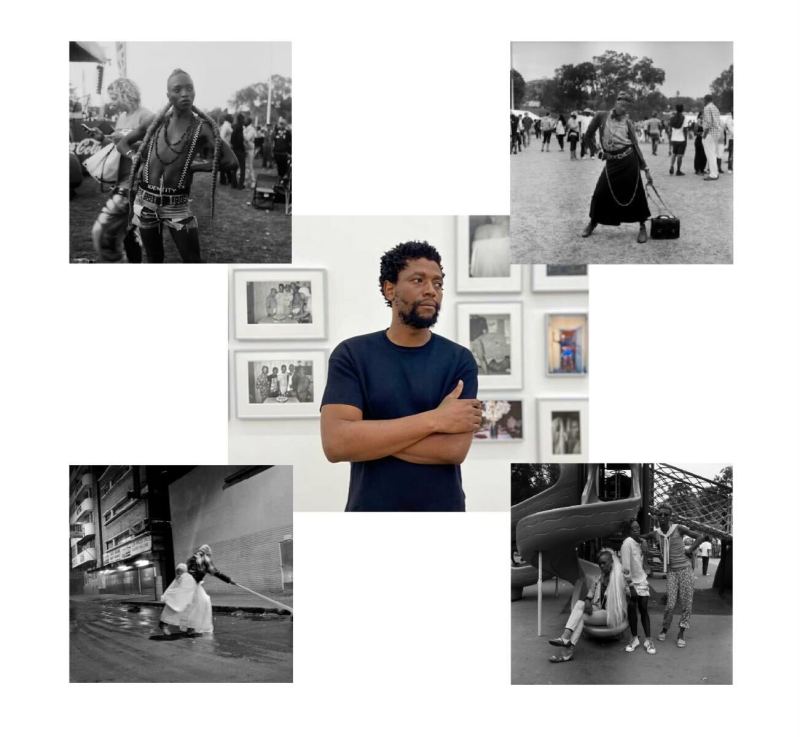Room 210 of the Cantor Arts Center is currently home to a collection of neatly-framed black and white photos, plus one oversized full-color sports team poster. This may seem like an eclectic assortment of images, but artist Sabelo Mlangeni chose each of them intentionally, seeking to capture the multifaceted identity of his community.
Mlangeni, a visiting artist in the history department this past fall, is a South African photographer whose art focuses on the oppressed and underrepresented communities around Johannesburg. His work “Imvuselelo: The revival,” which focuses on the members of the African Zionist community, is on display at the Cantor Arts Center until Jan. 21. Mlangeni spoke to The Daily about his exhibition and his time at Stanford.
This interview has been lightly edited and condensed for clarity.
The Stanford Daily (TSD): “Imvuselelo” revolves around the African Zionist movement. What inspired you to create it, and why is this important to you?
Sabelo Mlangeni (SB): Through the years, I’ve been disconnecting and reconnecting with the church. “Imvuselelo” started not as the kind of a work to be shown in an exhibition, but as me making photographs for the church community. In 2014, I went back to this work when I was thinking about healing and spirituality and the whole concept of being a born again.
TSD: How has your South African identity shaped your career and the way you view the world?
SB: I grew up in a country that totally excluded the natives in all spaces — education, work, everything. All those things shaped South Africa’s history and therefore shaped me and my identity. This was made clear when I moved around the world: Wherever you go, you can’t leave yourself behind. You always work with yourself. As a South African, I’m always reminded of where I’m coming from.
TSD: You’ve had many exhibitions throughout your career, including some on queer culture in Africa and daily life of rural South Africa. How has your previous work influenced this exhibition?
SB: I think something amazing with my work over time is that many of my collections overlap with each other. In “Imvuselelo,” you find that the community displayed here is my friends, who also appear in my other works. All my work is somehow connected because the subjects find a way of meeting each other in different projects.
TSD: How do your photos challenge the status quo?
SB: It depends on the body of work. Some are stronger than other works. Works like “Country Girls” and works that look at the LGBT community in rural Mpumalanga and the surrounding towns are really pushing the envelope. They focus on being able to openly live with your sexuality and be who you want to be in a small village. We are in a society that tells us, “You can’t do this. You can’t dress like that. You can’t say that,” even today.
TSD: What are your plans for the future?
SB: My plans for the future are to see where things go. It’s already been amazing to see how my images change over time. I started working in photography in 1997, and, at that time, I was young and I wasn’t aware of much. But the work that I made at that time still has the same impact it had back then, even when I show it today. I want to have this same impact in future years. That comes with the work being seen and being shown to people.
TSD: How do you like the Bay Area and its arts scene?
SB: I’m trying to see as much as possible and also to meet people. The people I have met are very kind and help direct me to places where I can meet other members of the arts community. I’m trying to take all my experiences here with me when I leave. I’m also thinking about creating something during my time in the Bay, and all this sort of engagement is helping me with that.
It is also amazing to be able to access museums. Most of the time, we engage with art through magazines, books or the screen, and to be able to experience the work of different artists in archives, collections and galleries is amazing.
TSD: Why did you choose to come to Stanford? How was your experience as a visiting artist?
SB: I’m still a student. I attended Market Photo Workshop, which started as a vocational school and later became a school for photography. Because of that, I’ve been very curious about residential academia. I wanted to experience living and learning in more academic spaces in order to close the gap in my curiosity.
Since 2010, I’ve been moving to different places. I like to learn and share what I’m doing as a photographer and, at the same time, see how different academic residences are structured differently. In these academic residences, I can have a community of people to engage more deeply with, and I have a different audience all the time.
